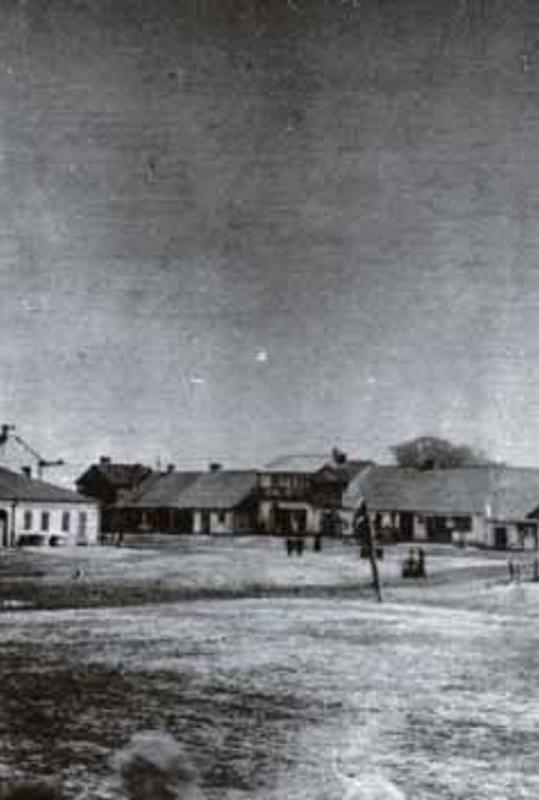The oldest surviving source reference attesting to the existence of the village of Siedliszcze dates back to 1421. In 1760. The owner of the estate, Wojciech Józef Longin Węgleński, received permission from King August III Sas to locate the town under Magdeburg law, along with a privilege for weekly markets and four fairs a year. In the 18th century. mainly Greek Catholics and Jews lived here, while the Roman Catholic population lived in the surrounding villages belonging to the estate. Its location on the route leading from Chelm to Leczna and Lublin, at the intersection with the road from Rejowiec to Cycow, positively influenced the development of trade and crafts in Siedliszcze.In 1821. Siedliszcze lost its municipal rights.In 1882. Half of the settlement's buildings burned down.At the end of the 19th century. There was an Orthodox church, a synagogue, an elementary school, a community office and a postal station. There was a small agricultural tool factory, a sparkling water factory, three tanneries, an oil mill, a distillery, two water mills located on the manor, and several inns and taverns. Residents were engaged in making chaises and sleighs, which they sold at fairs in Leczna.In August 1915. There were fierce battles between Russian and German troops in Siedliszcze and the surrounding area. The retreating Russians set fire to the settlement; the buildings in the center burned down in the fire.In the interwar period, Siedliszcze was a small settlement with an ethnically and religiously diverse population. In the 1930s. Two motor mills, three water mills, nine windmills and a distillery were built here.Jews in Siedliszcz - Until 1918. - The date of the appearance of the first Jewish settlers in Siedliszcze is not known. Wojciech Węgleński, anxious to accelerate the economic development of his town, encouraged Jews to settle in Siedliszcze, guaranteeing them full freedom of trade, the right to buy houses and build a synagogue. In 1765. The local Jews were subordinate to the municipality in Leczna.Most made a living from trade, crafts (blacksmithing, shoemaking and tailoring) and the lease of breweries. Probably at the beginning of the third quarter of the 18th century. The first synagogue was built, in 1867. while an independent religious community was established. In 1870. In addition to the synagogue and beit ha-midrash, there were a mikvah and a hospital-hospital at the community.In 1905. There was a community Talmud-Torah school and five private cheders. During World War I, nearly two-thirds of the settlement's residents left, including many Jews. The synagogue, mikvah and ritual slaughterhouse were destroyed.Interwar period - The majority of Jews made a living from crafts, trading in groceries, merceries, haberdashery and grain. Jewish entrepreneurs ran several industrial plants in the settlement and community, including. Herszek Hochman - motor mill, Eliezer Szmul and Mordko Holszenbaum - oil mills, bakery, Israel Rojzen - water mill in Brzeziny, Abram Zajdenwerg - water mill in Janowica, Abram Michalik - water mill in Dorohucza. Because of its modest income, the municipality was unable to rebuild the facilities destroyed during World War I and maintain them, so it lost its independence after the war. The Jews were temporarily subordinated to the community in Rejowiec.They soon took steps to rebuild the synagogue, mikvah, ritual slaughterhouse and regain the community's independence. In 1927. Under the administration of the restituted municipality in Siedliszcze were the surrounding settlements: Cyców (previously belonging to the municipality in Łęczna), Liszno, Kanie and Wólka Kańska. There were three beit ha- midrash in private buildings.Under the auspices of the community was the Linas ha-Cedek charity organization. Jewish political parties had their representation, including. Mizrachi and Agudah, which ran the Beit Yaakov religious school for girls. The youth Zionist organization Ha- Shomer ha-Cair and Beytar also had branches.Holocaust - In June 1940, the Germans created a ghetto in Siedliszcze, where they incarcerated approx. 2,000 Jews from the settlement and surrounding villages, displaced from Krakow and Lublin, in April 1942. While they resettled here about 3,000 Jews from Bohemia. They deported everyone in two transports to the Sobibor death camp on May 18, 1942.(630 people) and October 22 (1,000 people).During the liquidation of the Siedliszcz ghetto, the local Judenrat bought out approx. 800 people, who were sent to a labor camp in Novosiolki, and then shot.The Germans destroyed facilities belonging to the community.
1. Siedliszcze - Centrum miejscowości
Stories
Siedliszcze - village center
Jewish History Tours

Powered by Clio Muse Tours
Powered by Clio Muse Tours
